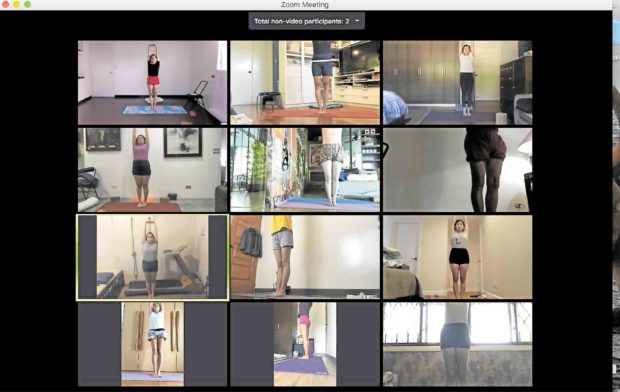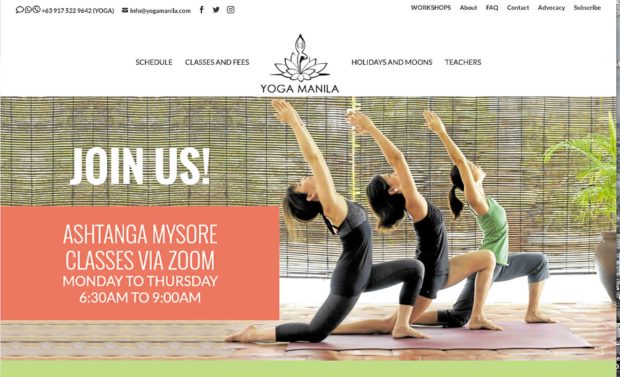
“Turn your right thigh in some more, Karen.”
I was teaching a general Iyengar yoga class, and this was the second time I was telling Karen (not her real name), one particular student, to work a little harder. “Sige pa, Karen, more. More. More!”My face was already up against the screen, my voice even louder with my microphone on—but Karen wasn’t moving, and appeared to have zoned out.
If I had been in the same room with her, zoning out would not have been an option; I would have been right next to her, turning her thigh out with my hand and adjusting her hips. Such physical adjustments are a hallmark of our style of yoga, which is particular about alignment and precision.
Instead, I had to let it go.
Many yoga teachers I know have had a lot of practice in letting go with online lessons, which have become the norm since the new coronavirus disease (COVID-19) closed yoga studios and forced dynamic, multidimensional classes to fit within the four sides of a cell phone or computer screen.
“I wanted to jump into the laptop that day, because some of the students just stopped trying,” says my teacher Rina Ortiz, director and founder of the Iyengar Yoga Center Manila (IYCM), talking about a special class for International Yoga Day she taught last June 21.
“In a class, it would be easier to encourage them to try, and you might also try a little harder as a student because you are there, and you get energy from those around you.”
“Because it won’t be easy for the teacher to make bantay every student, plus there is no peer pressure and you don’t have that energy that’s present when you attend an actual class, students may become more complacent when doing the poses,” seconds Audrey Shih, another IYCM teacher. “Or kung hindi kaya or pagod na sila, they just stop and rest. Kung baga, they won’t push themselves so much.”
Frustrating
It’s a problem that affects different styles of yoga, however. “It’s a bit frustrating when I can’t help people get into a pose by adjusting them,” agrees Berta Feliciano, cofounder of Yoga Manila, which teaches Ashtanga yoga. “I’ve had to be more thoughtful and precise when calling out poses or giving out corrections. It’s almost nakakagigil when you can’t convey precisely what you need to, but hey, the fact that people are on the mat is already the biggest win for me.”
“The teacher’s physical presence in the room is not just to get that last twist in or for a little nudge to stay on the wall, but it has enormous psychological benefits,” says Elena Laguinia, also a student of Ortiz’s, who runs Sankalpa, an Iyengar yoga studio in Quezon City. “Plus, coming to class is very much a social activity, so community interaction is limited with online classes.”

The low momentum in some cases also results from technical problems. “Initially, as a teacher, it’s difficult to get the student on screen with the entire mat and see them from head to toe, and we often need to get them at an angle, as well,” says Feliciano. “This setup alone is often difficult for most students to accomplish.”
“We can only go so far in terms of poses,” says IYCM manager and teacher Saree Kaluag. “Corrections slow down, as you cannot catch everyone’s attention in a Zoom class. And of course, there’s the super unreliable internet ng Pilipinas!” This last issue drove me up the wall, as well, as the country’s internet service providers have been quite inconsistent.
I myself gave up on our last, practically useless provider during lockdown, which had me dropping out two to three times during a class—a big problem if you’re teaching—and I signed up with a new one.
For teachers who own yoga studios, it is undoubtedly a losing proposition if the space is being rented, and is not owned. “If your bread and butter is teaching yoga, your income will really be less, and that means not even half of what you earn from a studio class,” says Susan Ordinanza, an IYCM teacher who also holds classes in a rented space in Manila. “There is a definite dent on finances, as you still have to pay rental or association dues.”
“Online teaching will be here to stay, given the fluidity of the COVID situation,” says Laguinia, who owns her space. “Classes in studios will take a back seat. Since we cannot have big groups at the studio, studio time will be for those willing to pay more to have private or small group classes. And because of that, it is expected that a lot of studios will fold.”
Listening better
For homebound students, however, Zoom yoga classes have been quite the godsend, teachers agree. “I realized, some students were listening better,” notes Ortiz. “One messaged me separately, saying she is grateful for the classes because at least now she can practice three to four times a week, something she wouldn’t have been able to do otherwise.”
Indeed, I have seen many regular students become stronger and do their poses better because of the frequency of online classes; some now have the option to attend class every single day.
“For a student, there’s no travel time, as traffic in Manila is bad,” says Ordinanza. “You have more time to practice for yourself. If finances and ability are not an issue, you can even join classes offered by foreign teachers. You don’t even have to wear a bra!”
“Watching people on Zoom will never replace an in-person experience for a teacher, but as a student, I love it,” says Feliciano. “I feel the same energy I get from being in a class. Zoom classes can involve people from all over the world now. Also, it’s crazy because you don’t even have to really get ‘dressed’ and can be more ‘casual’ in your choice of clothes.”
Kaluag likes to think students will be less lazy when doing yoga at home. “Since you’re ‘alone,’ there can be more awareness of what you can do. You realize that the teacher really becomes just a guide, rather than you not paying attention kasi nandyan naman yung teacher to correct you.
“Also, there is more intent to learn, because you have to invest in your props, and people have more time to figure things out.”
Laguinia is pretty sold on online classes now for both teacher and student. “It’s convenient—no travel, no parking problems, just jump out of bed. It’s safe because there’s no exposure, as you are in your own home. Online classes are cheaper than studio classes. You have your own space, and can extend your final corpse pose for as long as you like. And, there are no borders! We have students from Singapore, from Australia, from Davao.”
Thus, when there’s little overhead, the number of available students may eventually make up for the lower fees for online classes.
Ortiz admits it would be more difficult to teach raw beginners at this time, though. “It is easier to teach people whose bodies and frame of mind you already know. I would be really challenged to teach a beginner, but it can be done—though it’s really not the best for the art and science of yoga.”
A beginners’ class would have to have a different format and pace, Kaluag says. “We’re relying on visual cues to get the instruction across, but if they have little connection to their own bodies, medyo challenge.”
Like how, indeed, would you teach a beginner to turn her thigh in, if he or she has never really done it before?
Take more time
Laguinia has tackled the challenge by teaching a recent introductory series with two teachers, one to demonstrate a pose and another to just talk and check everyone. “We all just need to adapt to the changing landscape, so I try to use a lot of props to help students be aware of alignment because I cannot see them 360 degrees, given the limitations of this platform.
“It was a learning process for the teachers, too, but I think overall the students were satisfied. We just have to take more time to show and explain what we want done.”
Laguinia and I recently attended a three-hour workshop by senior Iyengar yoga teacher Bobby Clennell, which started at 10 a.m., New York time (so we actually did the workshop from 10 p.m. to 1 a.m., Manila time; it was 3 p.m. where Clennell was in Dorset, England).
I mentioned to Clennell that it was difficult getting adjusted to the new style of teaching Iyengar yoga, and not being able to handle students.
“That’s true,” she said. “But we’re still lucky to have this technology. And it’s really about making do with what we have.”
“Unless yoga studios ‘reinvent’ themselves, it will be difficult to survive,” Feliciano concludes. “I don’t think yoga is going away, but the very nature of teaching yoga does not fit into the mantra of maintaining social distance, avoiding prolonged exposure, and so on. So Zoom is definitely the way to go for now, and is the closest, for me, to being in an actual class.”
For Ortiz, the biggest advantage of virtual classes at this time is preserving the sense of community. “At a time like this, one can see and feel from their messages that they so need to be with others. It’s great that we are able to keep the community together and nourish ourselves with it.
“I just hope that when and if things return to the time when we can have a real class again, people don’t choose to just do a virtual class because it’s convenient.” INQ













































